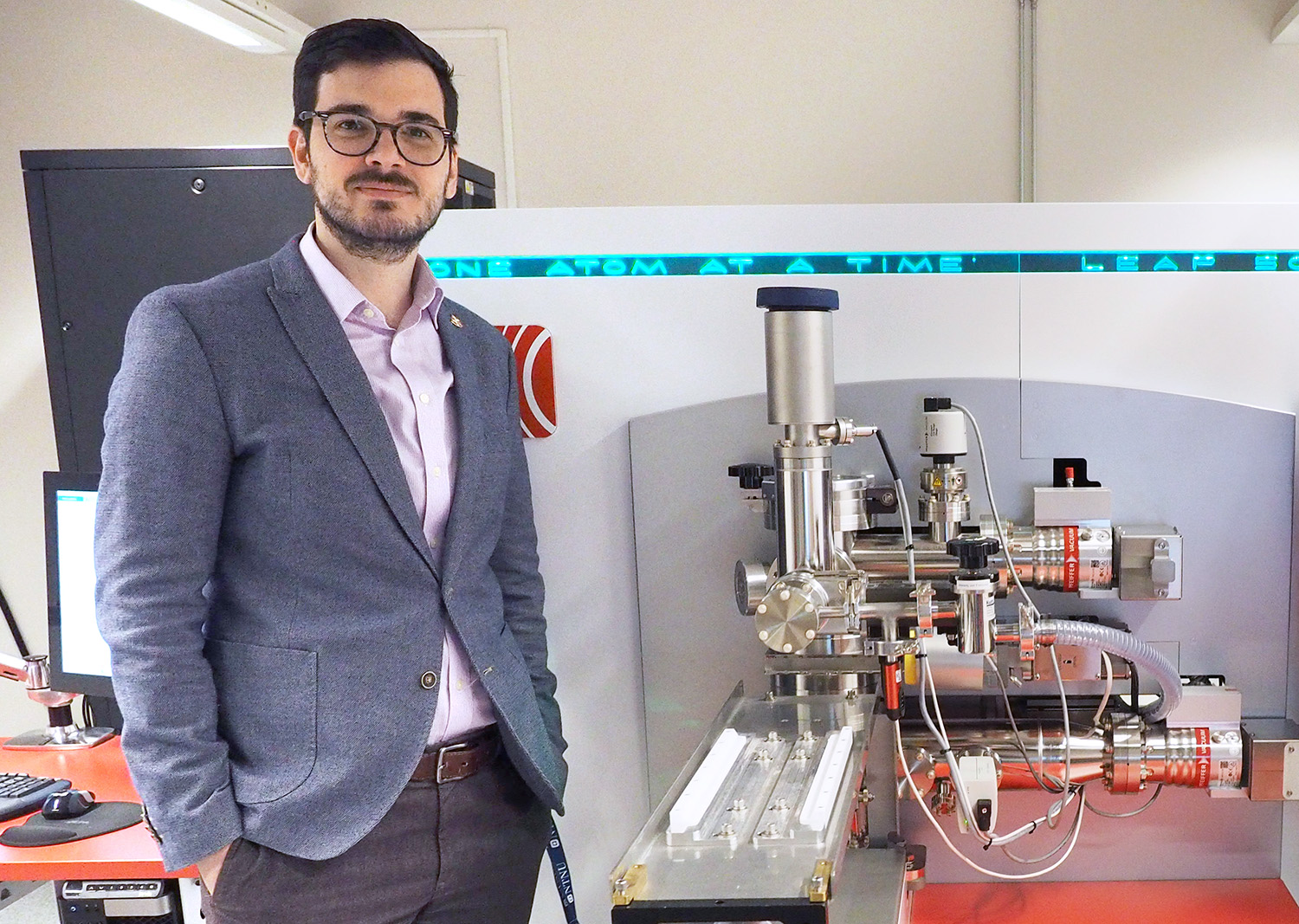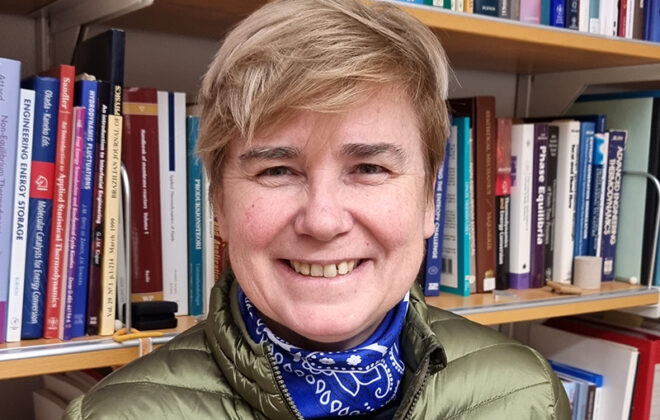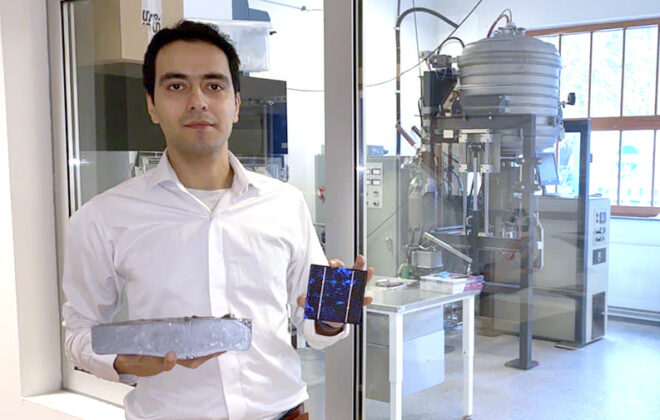You can actually see the atoms in 3D: Q&A with Paraskevas Kontis

Paraskevas (Paris) Kontis joined NTNU in September 2021 as Associate Professor in Materials Science and Engineering. His work focuses on the relationship between materials’ properties and chemistry at the atomic level. Here, he speaks with NTNU Nano science writer Kelly Oakes about his current research and plans for the future.
Can you tell me about your background?
I grew up in Athens, and studied metallurgy and mining engineering as an undergraduate in Greece. I moved towards material science for my masters’ degree in Greece and Germany as an Erasmus student, and continued later with my PhD at the University of Oxford. That was the first time I worked on atom probe tomography, which led me to where I am today.
How would you sum up your research in three key words?
Atomic-scale engineering.
You’re responsible for the atom probe tomography lab at NTNU. What exactly is atom probe tomography?
Imagine that we have a sharp needle and we try to remove the atoms layer by layer from the surface of this needle. As they are removed, the atoms fly towards a detector that measures their position and the time they take to reach the detector. This technique destroys the material, but using the information from the detector we can reconstruct the volume we are analysing and see the composition – down to the atomic scale – of a particular metal or alloy. That gives us a lot of information. The way the atoms are positioned within the material controls their properties, so by knowing their location, we can control their properties and develop new materials, or improve the materials that we currently use in everyday life.
For example, my research is focused on high temperature alloys that we use in aeroplane engines. Using atom probe tomography we can see how their composition changes after many hours of flying, leading to their degradation. Then we develop material design strategies to delay such compositional changes.
What was your last paper about?
It was on aerospace titanium alloys and we were trying to understand something called stress-corrosion cracking, where a material breaks apart suddenly under specific conditions. By using different methods, including atom probe tomography, we got some new insights challenging current understanding.
Although we always thought that hydrogen was the main cause of stress-corrosion cracking, we saw that was actually not the case. It turns out that oxygen plays a vital role, by changing the microstructure and facilitating the formation of cracks.
What first got you interested in this work?
The first time I was introduced to atom probe tomography was in 2013 in Oxford. When I saw the beauty of it, it was love at first sight: you can actually see the atoms in 3D.
As a technique it is not new, but it has only recently been possible to perform it routinely, reliably and with enough data to do these experiments on a daily basis. There are not many places in the world that have this equipment, but this is changing slowly.
Why did you choose NTNU?
Since Oxford, it was my dream to lead an atom probe lab and work on high temperature alloys – I’ve been working really hard these past years towards that goal.
But it’s not just about research. I’m the father of a two-year-old, and people have told me Norway is a good place to raise a family. Our move here was complicated by the pandemic – we had to bring forward our flight by several days because the borders were due to close – but NTNU was very supportive throughout the process.
Where will you be working within NTNU?
There are three key labs. I start my work at the electron microscopy lab that we have here at the Department of Material Science Engineering – that’s really important for my research, but also for other researchers across NTNU. From there it’s NanoLab, where I prepare the atom probe samples, and then I take them to the atom probe tomography lab.
What are you working on next?
I’m developing my work on hydrogen and NTNU is the perfect place for that. We believe hydrogen could be used in aeroplane engines as an alternative fuel to reduce emissions. But at the same time, it’s causing a lot of problems in metallic materials by making them more brittle, and so more likely to break at unpredictable times, and we don’t know much about that.
Another exciting project, in the very early stages, is one I’m working on in collaboration with colleagues from my department on batteries. We want to look at them at the atomic scale and see how their composition changes when you charge and discharge your mobile phone many times, for example. If you can understand that, it could be a first step towards making batteries last longer.
What’s the biggest challenge remaining in your field?
Hydrogen is the biggest challenge in my mind. If you want to integrate hydrogen in our everyday life, as aviation fuel, in power plants, or even in some cases to fuel cars and trucks, we need to know how to protect the materials [it comes into contact with] from breaking.
Hydrogen is the smallest atom, it diffuses very fast and it’s very difficult to track it inside the material. But if you cannot see where it is then you don’t know how to deal with it. We’re starting to find answers using atom probe tomography, but there is more work to do.
What do you most enjoy about your work?
The excitement of a successful experiment, especially one done by a student. As scientists we publish our results, but we rarely say how much time we spent to get that published result. When you finally manage to collect the data that you were hoping for, it’s one of the best feelings.
What motivates you?
I want to leave the planet in a better place than I found it. I hope I can make a small contribution towards making aviation more sustainable.
What do you do in your spare time?
I spend most of it with my family. Next winter, I want to take up cross country skiing so I can go out together with my daughter – she’s already learning how to ski in kindergarten.

Kelly Oakes
Kelly Oakes is writing science articles for NTNU Nano. She is a freelance writer and editor living in London.
Tags In
Search
Søk
Categories
- Arctic Research
- Arkitektur
- Bærekraft
- Bioingeniørfag
- Biologi
- Biology
- Biomedical Laboratory Science
- Biotechnology
- Bioteknologi
- Chemical Engineering
- Chemistry
- Climate
- Computer Science
- Datateknologi
- Digital
- Elektronikk
- Energi
- Energi
- Energy
- Engineering
- Engineering
- Environment
- Food Science
- Forskning
- Fysikk
- Fysikk
- Havbruk
- Informasjonsteknologi
- Informasjonsteknologi
- Ingeniørvitenskap
- Kjemi
- Kjemisk prosessteknologi
- Kjemisk prosessteknologi
- Kreftbehandling
- Kybernetikk
- Marine Technology
- Materialer
- Materials Science
- Materialteknologi
- Matvitenskap
- Meninger
- Miljø
- Min ph.d.
- My PhD
- My PhD
- My postdoc
- Nanotechnology
- Nanoteknologi
- Ocean
- Oil and gas
- Physics
- Research
- Simulering og visualisering
- Spør en forsker
- Studentliv
- Sustainability
- Ukategorisert
- Universitetsliv
- University Life
Kategorier
- Arctic Research
- Arkitektur
- Bærekraft
- Bioingeniørfag
- Biologi
- Biology
- Biomedical Laboratory Science
- Biotechnology
- Bioteknologi
- Chemical Engineering
- Chemistry
- Climate
- Computer Science
- Datateknologi
- Digital
- Elektronikk
- Energi
- Energi
- Energy
- Engineering
- Engineering
- Environment
- Food Science
- Forskning
- Fysikk
- Fysikk
- Havbruk
- Informasjonsteknologi
- Informasjonsteknologi
- Ingeniørvitenskap
- Kjemi
- Kjemisk prosessteknologi
- Kjemisk prosessteknologi
- Kreftbehandling
- Kybernetikk
- Marine Technology
- Materialer
- Materials Science
- Materialteknologi
- Matvitenskap
- Meninger
- Miljø
- Min ph.d.
- My PhD
- My PhD
- My postdoc
- Nanotechnology
- Nanoteknologi
- Ocean
- Oil and gas
- Physics
- Research
- Simulering og visualisering
- Spør en forsker
- Studentliv
- Sustainability
- Ukategorisert
- Universitetsliv
- University Life



